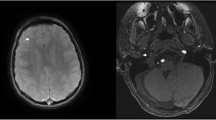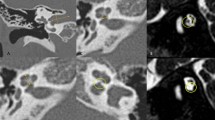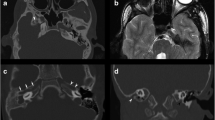Abstract
Purpose
To characterize the types of hearing loss, auditory-related imaging findings, and hemangioma characteristics in patients with Posterior fossa malformations, Hemangiomas, Arterial anomalies, Cardiac defects, and abnormalities of the Eye (PHACE) syndrome.
Methods
Retrospective medical records, audiologic data, and imaging review of all patients presenting to a tertiary care children’s hospital with a proven diagnosis of PHACE syndrome from 2005 to 2016.
Results
Twelve patients were identified with hearing and imaging data. 5/12 had hearing loss, 1 had unilateral severe sensorineural loss with minor conductive component, 1 had unilateral moderate sensorineural loss with minor conductive component, 1 had mild bilateral conductive loss, 1 had bilateral hearing loss (left severe mixed and right severe sensorineural), and 1 had moderate bilateral conductive loss. All patients passed their newborn hearing screening. Of the 5 patients with hearing loss, 3 had IAC hemangiomas (1 bilateral), 3 had enlarged IACs with prominent posterior petrous bones (1 bilateral), 2 had dysgenesis of the cerebellar vermis and hemispheres, there was 1 patient each with a deformed pinna and middle ear and mastoid effusions, and 1 patient had no abnormal auditory-related imaging findings. Patients with hearing loss were more likely to have more areas of cutaneous hemangioma involvement (mean 6.4 vs 3.1, p = .05). Laterality of hearing impairment correlated with the side of cutaneous hemangioma in all patients with hearing loss. Treatment with systemic propranolol did not improve hearing.
Conclusions
Patients with PHACE are at risk for hearing loss and may demonstrate radiologic abnormalities within the ear structures, although the type of hearing loss, imaging findings, and their respective correlation vary. While our results are limited by our small sample size, comprehensive audiology evaluations (as opposed to newborn screening testing only) should be considered for PHACE patients who have extensive cutaneous hemangioma or auditory-related imaging abnormalities, such as internal auditory canal hemangiomas.



Similar content being viewed by others
References
Garzon MC, Epstein LG, Heyer GL et al (2016) PHACE syndrome: consensus-derived diagnosis and care recommendations. J Pediatr 178:24–33.e22
Bangiyev JN, Gurgel R, Vanderhooft SL, Grimmer JF (2017) Reversible profound sensorineural hearing loss due to propranolol sensitive hemangioma in an infant with PHACE syndrome. Int J Pediatr Otorhinolaryngol 103:55–57
Duffy KJ, Runge-Samuelson C, Bayer ML, Friedland D, Sulman C, Chun R, Kerschner JE, Metry D, Adams D, Drolet BA (2010) Association of hearing loss with PHACE syndrome. Arch Dermatol 146:1391–1396
Hartemink DA, Chiu YE, Drolet BA, Kerschner JE (2009) PHACES syndrome: a review. Int J Pediatr Otorhinolaryngol 73:181–187
James PA, McGaughran J (2002) Complete overlap of PHACE syndrome and sternal malformation—vascular dysplasia association. Am J Med Genet 110:78–84
Meltzer DE, Robson CD, Blei F, Holliday RA (2015) Enlargement of the internal auditory canal and associated posterior fossa anomalies in PHACES association. AJNR Am J Neuroradiol 36:2159–2162
Poindexter G, Metry DW, Barkovich AJ, Frieden IJ (2007) PHACE syndrome with intracerebral hemangiomas, heterotopia, and endocrine dysfunction. Pediatr Neurol 36:402–406
Rudnick EF, Chen EY, Manning SC, Perkins JA (2009) PHACES syndrome: otolaryngic considerations in recognition and management. Int J Pediatr Otorhinolaryngol 73:281–288
Dilwali S, Landegger LD, Soares VY, Deschler DG, Stankovic KM (2015) Secreted factors from human vestibular schwannomas can cause cochlear damage. Sci Rep 5:18599
Bess FH, Dodd-Murphy J, Parker RA (1998) Children with minimal sensorineural hearing loss: prevalence, educational performance, and functional status. Ear Hear 19:339–354
Cunningham M, Cox EO (2003) Hearing assessment in infants and children: recommendations beyond neonatal screening. Pediatrics 111:436–440
Martin KL, Arvedson JC, Bayer ML, Drolet BA, Chun R, Siegel DH (2015) Risk of dysphagia and speech and language delay in PHACE syndrome. Pediatr Dermatol 32:64–69
Mamlouk MD, Nicholson AD, Cooke DL, Hess CP (2017) Tips and tricks to optimize MRI protocols for cutaneous vascular anomalies. Clin Imaging 45:71–80
Mamlouk MD, Hess CP (2016) Arterial spin-labeled perfusion for vascular anomalies in the pediatric head and neck. Clin Imaging 40:1040–1046
Wright JN, Wycoco V (2017) Asymmetric Meckel cave enlargement: a potential marker of PHACES syndrome. AJNR Am J Neuroradiol 38:1223–1227
Krings T, Geibprasert S, Luo CB, Bhattacharya JJ, Alvarez H, Lasjaunias P (2007) Segmental neurovascular syndromes in children. Neuroimaging Clin N Am 17:245–258
Chilosi AM, Comparini A, Scusa MF et al (2010) Neurodevelopmental disorders in children with severe to profound sensorineural hearing loss: a clinical study. Dev Med Child Neurol 52:856–862
Author information
Authors and Affiliations
Corresponding author
Ethics declarations
This study was approved by the institutional review board, which waived the requirement for informed consent.
Conflict of interest
The authors declare that they have no conflict of interest.
Additional information
Presented as an abstract at 2016 International Society for the Study of Vascular Anomalies Conference in Buenos Aires, Argentina
Rights and permissions
About this article
Cite this article
Mamlouk, M.D., Zimmerman, B., Mathes, E.F. et al. Hearing loss in PHACE syndrome: clinical and radiologic findings. Childs Nerv Syst 34, 1717–1724 (2018). https://doi.org/10.1007/s00381-018-3822-x
Received:
Accepted:
Published:
Issue Date:
DOI: https://doi.org/10.1007/s00381-018-3822-x




